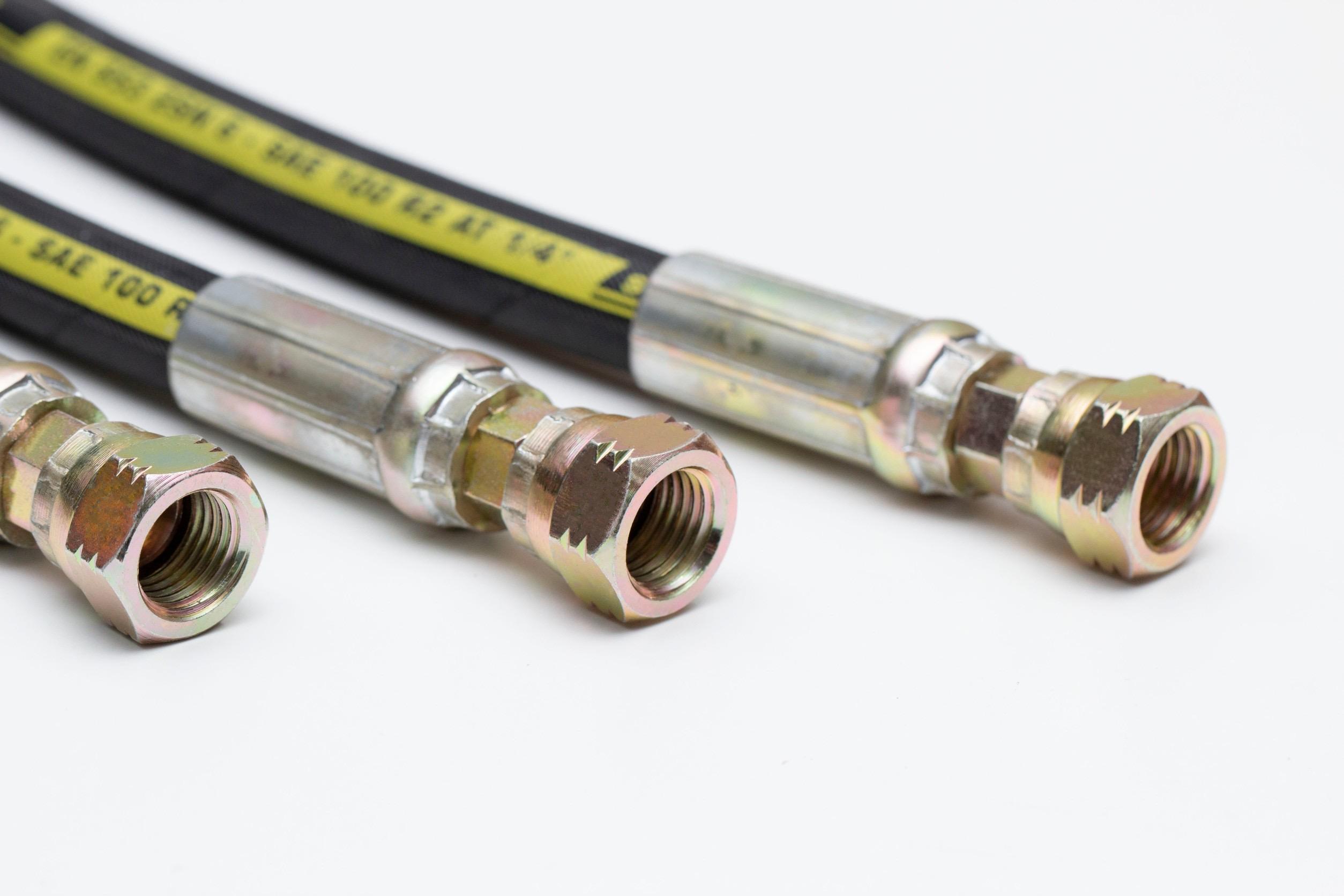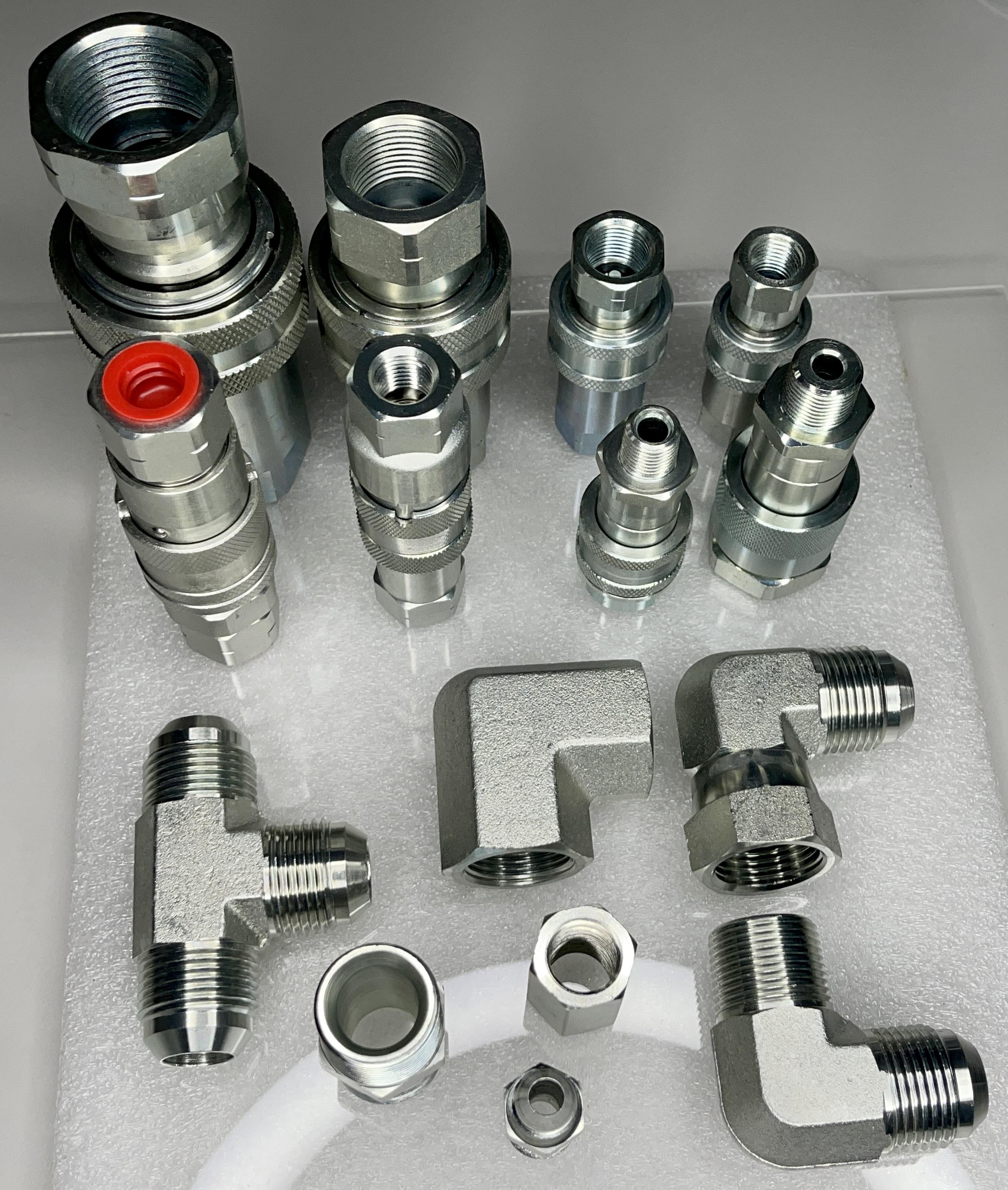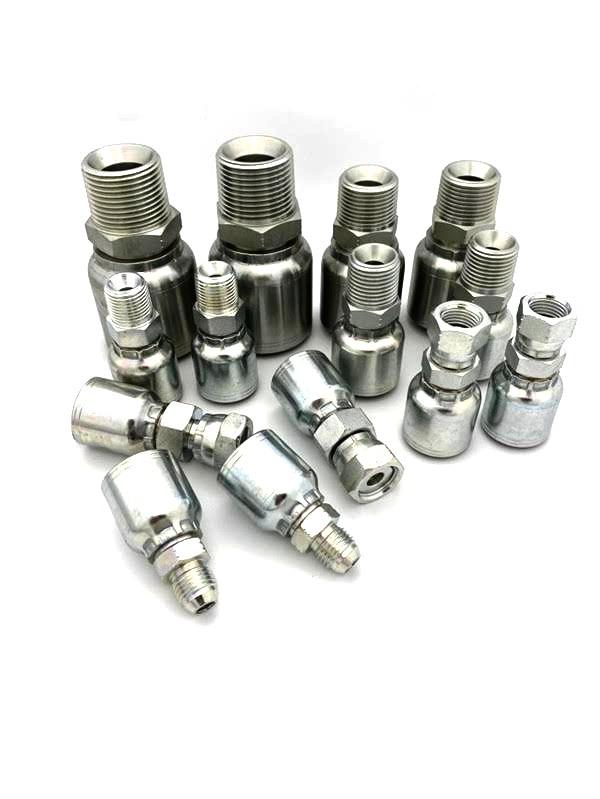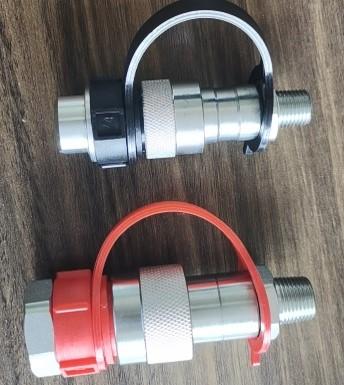Basics of Hydraulic Systems ( Part 1 )

Hydraulics Training Manual
BASIC HYDRAULICS AND HYDRAULIC PLUMBING

Synthetic rubber hoses
TYPES OF HOSE
Aircraft hose is composed of two or more layers of differing materials. The inner layer, or liner, is a leak-tight nonmetallic tube made from either synthetic rubber or teflon. The liner is reinforced against swelling or bursting by one or more outer layers of braid that encircle it. The kind and number of layers of braid depend on the intended operating pressure range of the hose assembly.
The two materials used as inner liner for flexible hoses are synthetic rubber and teflon. The two materials and their uses are discussed in the paragraphs that follow.
Rubber Hose.
The inner liner of rubber hose used in aircraft plumbing systems is made of synthetic rubber. Various compounds of rubber are used for these inner liners. Each compound provides the hose with some special capability, such as usability with certain fluids or operability within certain ranges of temperature. The outer covering of rubber hose is made of either fabric or rubber.
Rubber hose is used in aircraft plumbing systems only in the form of assemblies. An assembly is formed by attaching metal end connections to each end of a section of bulk hose.
Teflon Hose.
Teflon is the registered name for tetrafluoroethylene, which is a synthetic resin. Teflon hose has a flexible leak-proof inner tube, reinforced on the outside with one or more layers of stainless steel braid. The teflon linear is chemical inert to all fuel, oil, alcohol, water, acid, and gas. The linear can withstand fluid temperatures ranging from -100 F to + 500 F (-73 C to +260 C). Like rubber hose, teflon hose is used in aircraft plumbing systems only as assemblies.

Marking on Rubber Hose.
Bulk rubber hose has ink or paint markings on its outer cover for identification. The information provided by these markings include the identity of the manufacturer, date made, size, and military specification number. The military specification (MS) number provides additional information when referenced with a specification table of TM 1-1500-204-23-2. This information includes the hose-pressure capability, temperature limitations, and the fluids that can be used. On some hose, a lay strip provides an easy method to determine if an installed hose is twisted.
To identify field-fabricated rubber hose assemblies, a metal band is placed around the hose to identify the federal or national stock number of the assembly and to give the operating pressure and pressure test date.
Fabricating Medium-Pressure Rubber Hose Assemblies.
Medium pressure rubber hose assemblies are fabricated from bulk hose conforming to military specification MIL-H-8794 and fittings conforming to military standard MS 28740. Prior to the assembly process and before cutting, visually check the bulk hose for any mutilations, marks, seams, and excessive graphite. Check the fittings for mutilations to the threaded areas, nicks, distortions, scratches, or any other damage to the cone seat sealing surface, or to the finish that can affect the corrosion resistance of the fitting.

After the hose and fittings have been inspected, determine the correct length of hose required as shown in Figure 2-15. Cut the hose squarely, using a fine tooth hacksaw; then, using compressed air, clean the hose to remove all cutting residue.

Fabricating High-Pressure Teflon Hose Assemblies.
High-pressure teflon hose assemblies are manufactured from bulk hose conforming to MIL-H-83298 and end fittings conforming to MIL-H-83296.

Figure 2-16. Assembly of Hose and End Fitting.
INSTALLING HOSE ASSEMBLIES
During operation, the hose assemblies changes in length from +2 percent to -4 percent because of pressurization. To compensate for this, slack equal to at least five percent of the hose length must be allowed for expansion and shrinkage. The five percent allowance must be provided during cutting and fabricating. In addition to hose length, care must be taken not to twist the hose or to exceed the allowed bend radius. Supports and grommets must be used, fittings lubricated, and protection against temperature provided. Each of these is discussed in the paragraphs that follow and illustrated in
Figure 2-17.
Twisting.
Most hose is marked with a lengthwise solid line (lay strip) for ease in detecting any twists of the line during installation. A twisted hose tends to untwist when pressurized causing the end fitting to become loosened or sheared. To avoid twisting hose assemblies when connecting the second end, use two wrenches: one to hold the stationary fitting and one to turn the swivel nut.
Bend Radius.
Hose, like rigid tubing, has a limit to its bend allowance. Bends exceeding the permissible limit lead to early failure of the hose assembly. The radius of the sharpest bend permissible for a hose is referred to as the minimum bend radius for that hose. This bend radius is measured in the same manner as the
minimum bend radius of rigid tubing as described in the paragraph of this lesson entitled “routing of lines”.
Supports and Grommets.
Teflon hose requires a different kind of support than that used for rubber hose. However, the following principles in using supports apply to both rubber and teflon hose.
Hose must be supported along its length at intervals of 24 inches or less, depending on the size of the hose. These supports, shown in Figure 2-18, must be installed in such a manner that they do not cause deflection of any rigid lines where they are connected.
When a hose is connected to an engine by a hose clamp, a support must be placed approximately three inches from the connection, and at least 1-1/2 inches of hose slack provided between the connection and the engine, to keep vibration and torsion from damaging the connections.
When a hose passes through a bulkhead, a grommet must be installed in the bulkhead hole to provide support for the hose and to prevent it from chafing. As an alternative, a cushioned clamp can be used at the hole if the hole is large enough to provide adequate clearance around the hose.
A hose assembly connecting two rigidly mounted fittings must be supported firmly but not rigidly.
Lubrication.
The swiveling parts and mating surfaces-of hose assemblies must be lubricated before installation. This ensures effective seating and tightening of the component parts. Oil or water can be used on all, types of fuel, oil, and coolant hose when installation is made except for self-sealing hose which must never be lubricated during installation. However, only oil or the operational fluid of the system must be used on hydraulic and pneumatic hose.

Figure 2-17. Connecting Hose Assemblies.

Figure 2-18. Hose Support.
Temperature Protection.
Hose must be protected from high temperatures such as exhaust blast and hot engine parts. In these areas the hose must either be shielded or relocated. A shield for temperature protection is shown in Figure 2-19.

Figure 2-19. Temperature Protection.
STORAGE
Proper storage and handling of aircraft hose and hose assemblies are the responsibility of all activities engaged in aircraft maintenance. Aircraft hose and associated rubber components must be stored in a dark, cool, dry place protected from exposure to strong air currents and dirt. Stored rubber hose and seals must also be protected from electric motors or other equipment emitting heat or ozone. Hose and hose components must be stored in the original packing and issued so that the oldest items are issued first. Neither teflon nor rubber hose has limited shelf life. However, prior to installation all hose assemblies must be inspected to ensure serviceability and tested according to the procedures listed in the paragraph on testing hose assemblies.
Bulk Hose.
Prior to being placed in storage, the ends of the hose must be capped to prevent flareout and dirt contamination. Storage in a straight position is the preferred manner; however, if coiling is necessary, large loose coils must be made.

Hose Assemblies.
The ends of all hose assemblies must be capped during storage with polyethylene protective plugs conforming toNational Aerospace Standard (NAS) 815 or equivalent to prevent contamination.
Flexible hoses .
(1) Rubber Hose.
Rubber hose is a flexible hose that consists of a seamless, synthetic rubber tube covered with layers of cotton braid and wire braid. Figure 2-22, page 2-20, shows cut-away views of typical rubber hose. An inner tube is designed to withstand material passing through it. A braid, which may consist of several layers, is the determining factor in the strength of a hose. A cover is designed to withstand external abuse.
When installing flexible hose, do not twist it. Doing so reduces its lift and may cause its fittings to loosen. An identification stripe that runs along the hose length should not spiral, which would indicate twisting (Figure 2-23).
Protect flexible hose from chafing by wrapping it lightly with tape, when necessary.
The minimum bend radius for flexible hose varies according to its size and construction
and the pressure under which a system will operate. Consult the applicable publications that contain the tables and graphs which show the minimum bend radii for the different types of installations. Bends that are too sharp will reduce the bursting pressure of flexible hose considerably below its rated value.
Do not install flexible hose so that it will be subjected to a minimum of flexing during operation. Never stretch hose tightly between two fittings. When under pressure, flexible hose contracts in length and expands in diameter.

Figure 2-22. Flexible rubber hose
(2) Teflon™-Type Hose.
This is a flexible hose that is designed to meet the requirements of higher operating pressures and temperatures in today’s fluid-powered systems. The hose consists of a chemical resin that is processed and pulled into a desired-size tube shape. It is covered with stainless-steel wire that is braided over the tube for strength and protection. Teflon-type hose will not absorb moisture and is unaffected by all fluids used in today’s fluid-powered systems. It is nonflammable; however, use an asbestos fire sleeve where the possibility of an open flame exists.

Figure 2-23. Installing flexible hose
Carefully handle all Teflon-type hose during removal or installation. Sharp or excessive bending will kink or damage the hose. Also, the flexible-type hose tends to form itself to the installed position in a circulatory system.










You must be logged in to post a comment.